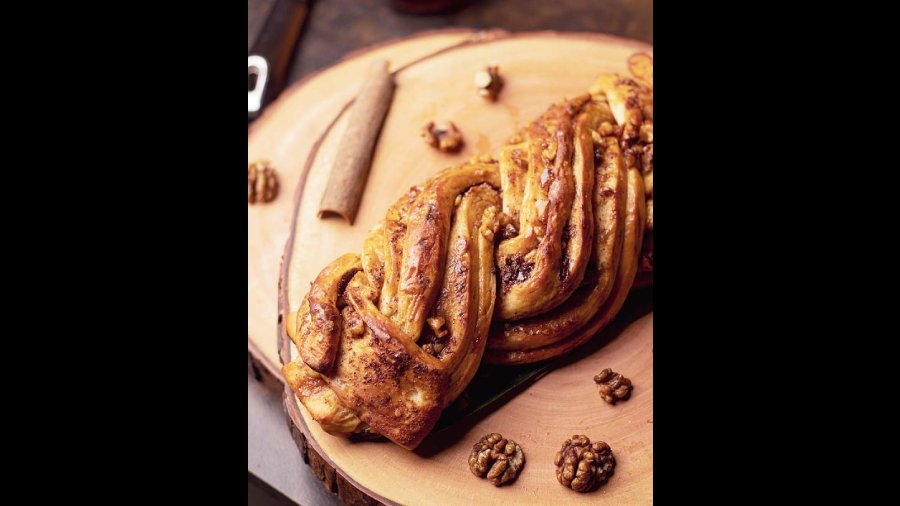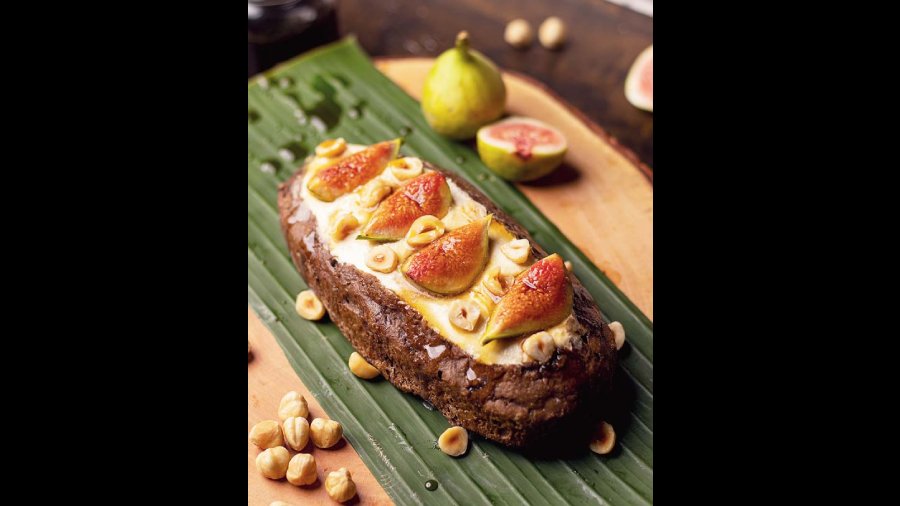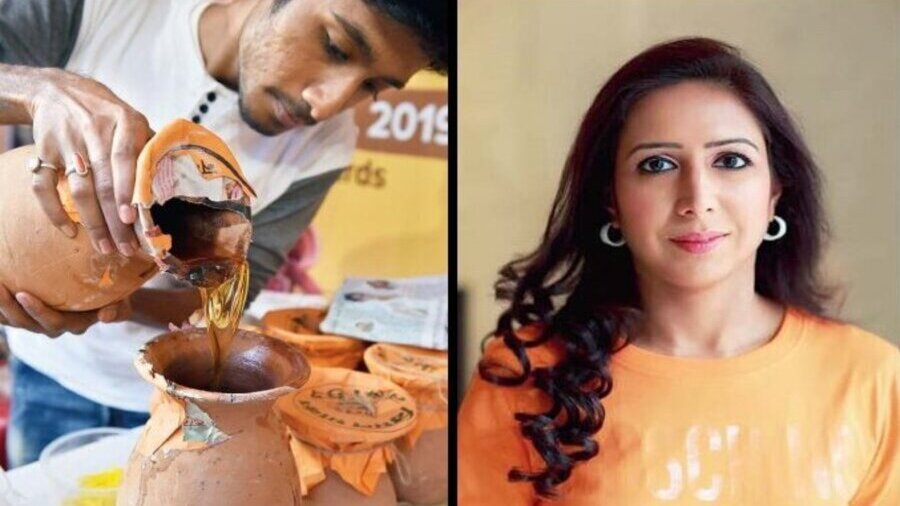Winters in Kolkata equate to a few things — picnics at the Victoria Memorial, foggy mornings, monkey caps and lots of nolen gur making its treacly way into sandesh, payesh and everything sweet, slowly and steadily nudging out white sugar with its golden-hued deliciousness.
What is Nolen Gur?
Every winter, with the fresh peas and bright carrots comes the bounty of fresh date palm jaggery. Bengal, already well known for its prowess in the dessert category, takes on a new avatar when nolen gur is introduced into its arsenal.
But, before all else, let me tell you a little about what this gur or jaggery is. Jaggery is usually made from sugar cane juice, thickened over a heat source. This produces a caramel, a cloyingly sweet product. Nolen gur, on the other hand, is produced from the sap of the date palm tree, giving the product complexities otherwise unknown to the realm of jaggery.
The process is arduous and very skilled — as shiulis, sap collectors, start off at dusk by climbing the trees and making insertions below the floral bunches where the golden sap collects. Earthen vessels inserted there are left overnight, to collect the sweet goodness, which is soon processed into jaggery. The date palm sap is very sensitive to climatic conditions — it cannot be tapped if the weather is warm, foggy or rainy, since the sap can become sour and cloudy. If the sap is left out too long, the heat from the sun starts to ferment the delicate liquid, producing a mild alcohol.
The sap, liquid as clear as water, mildly sweet and full of nutrients, is strained and boiled until slightly viscous. It takes on a caramel golden hue, and an intoxicating smell, which is sure to turn anyone into a fan.
The Jiren and Jhola of Jaggery
Much like all the good things in life, obtaining the gur from the date palm is also a painstakingly dedicated task. The word nolen has its roots in the Bengali word for new, and also in nol, or tap, which is used to divert the sap into the vessel during collection. The most popular version is the liquid jhola gur. Paused short of crystallisation, this jaggery is a viscous liquid of high aroma and tastes sublime.
The jhola gur is of the highest quality. This is made from the first fetch of tree sap, resulting in a sweeter, more aromatic product. The tree can be sapped a second time, producing a jiren gur, which is not as aromatic or heady.
The liquid, khejur ros, or the tree sap, is boiled for almost an hour, producing the jhola gur — the liquid jaggery that resembles a slightly runny honey in texture. If it isn’t boiled enough, it wouldn’t produce the viscosity, and if it were left to be boiled over, it crystallises to create patali gur, a hard mass we normally associate with jaggery, which has a longer shelf life, but unfortunately due to the process, loses out on some of the subtler flavour profiles of the jhola gur.
The highest-ranking gur, however, is the poyra gur, which is from the very first fetch of the season — the elongated resting period of the date palm results in incredible flavours bursting with depth.
Uses of gur
A variety of sweetmeats is made with nolen gur in winters. The nolen gur-er rosogolla and jolbhora sandesh, with its filling of nolen gur, find pride of place at Bengali mishti shops in winter.
The nolen gur can also famously be found in Joynager’er moya, a delightful combination of popped rice from the Joynagar district of South 24 Parganas, khoi, dehydrated milk solids, cardamom, poppy seeds, nuts, raisins and the uber rich jhola gur. When mixed together, and formed into balls, this dessert draws its takers from far and near, an ultimate winter favourite.
Gur can be swapped for much of everything that you would use sugar for. From payesh to patishapta, a Bengali rice pancake with coconut and jaggery filling, jhola gur finds many uses throughout the winter season, including slathering it on a slice of white bread under the warm January sun!
New innovations
Up until a few years ago, the amber-coloured, sweet liquid was a treat reserved for the winters, and ran the risk of going moldy once it ran its best before date. It was only recently that the village industries board came up with the idea of marketing jhola gur in a toothpaste style tube to increase shelf life, and it’s been a hit.
Other than that, nolen gur has found its way into unusual environs, such as ice creams. Local manufacturers have incorporated the flavours into a delectable ice-cream flavour, but still must adhere to the seasonability of the finicky liquid.
Gur vs Sugar
Sweet things usually get a bad reputation. Their effects on blood glucose and overall obesity are less desired aspects of the high they provide. However, there’s some good news; jhola gur is definitely easier on the system as opposed to traditional sugar, and here’s why:
l It helps with digestion as it activates certain enzymes
l Jhola gur is high in iron, potassium and magnesium.
l It is a natural sweetener — packed with antioxidants.
Now, we don’t recommend drinking it by the gallons, but if you were to indulge a little, don’t feel too bad about it. Quite recently, we substituted pancake syrup for nolen gur, and boy, was it a flavour blast!
The future of gur
The demand for nolen gur may have gone up but supply is an issue. The sap production has reduced over the years, and the output per khejur tree is lower. Climate change and overall global warming has inched temperatures upwards in the date palm producing areas. Warm weather does not lend well to the sap collection process, leading to a decline in the quantity and quality of the khejur ros produced.
The uncertainty of the business is also pushing the youth to not join the very skilled legions of the shiulis, the tree sap collectors, who rely on their expertise. The physically strenuous job is no longer a draw for the next generation. The process of thickening the gur is also an arduous task, which doesn’t help the gur’s case.
It is a difficult time for the shiulis, but here’s hoping organising the sector further will help these small farmers retain their skill set, and keep this glorious bounty of goodness flowing.
Vidisha Bathwal is the founder of Paprika Gourmet, an exotic artisan catering service brand in Kolkata. She’s also a passionate foodie and a fitness enthusiast

Nolen gur babka
Makes 3 loaves; 10 to 12 slices each
INGREDIENTS
• 3/4 cup water
• 1tbsp active dry yeast
• 3/4 cup whole milk
• 4 large eggs
• 1 large egg yolk
• 3/4 cup nolen gur
• 1 1/2tsp salt
• 1 1/2tsp vanilla extract
• 6 1/2 cups all-purpose flour
• 12 tbsp unsalted butter, softened to room temperature
For the filling:
• 2 1/4 cups walnut
• 3/4 cup butter (salted)
• 1 1/2 cups packed dark nolen gur
• 3tsp cinnamon
For the egg wash:
• 1 large egg yolk
• 1tbsp whole milk or cream
INSTRUCTIONS
• Make the dough: Combine the water and the yeast in the bowl of a stand mixer, and let stand until the yeast is dissolved. Add the milk, eggs, yolk, sugar, salt, and vanilla extract, and whisk until the yolks are completely combined. Add 6 1/2 cups of flour and stir with a stiff spatula until a shaggy, floury dough is formed.
• Now, using a dough hook, knead on medium-low speed until the dough comes together and is no longer floury, about 5 minutes. With the mixer still running, begin adding the butter in 1tbsp blobs. Mix until one blob is just barely incorporated before adding the next blob.
• Chill the dough: Transfer the dough to a mixing bowl. Cover and let rise for 1 .5 hours, until doubled in size. Transfer to the fridge and chill for at least an hour.
• Prepare the filling: Heat the oven to 200°C and toast the walnuts for about 5 minutes. Transfer the hot walnuts to a cutting board and chop them finely while still warm.
• In a medium bowl, mash together the softened butter, nolen gur, and cinnamon for the filling with a fork or a spoon, then work in the nuts. Keep mashing and mixing until the nuts are evenly distributed and you have formed a crumbly paste.
• Cover the shaped loaves and let them rise on the counter until puffy and just starting to dome over the tops of the pans, 1.5 hours.
• Bake the loaves: When the loaves have risen, whisk the yolk and the milk together to make the egg wash and gently brush it all over the surface of the loaves. Bake for 20 to 25 minutes. Finally drizzle with nolen gur.

Labneh, hazelnut caramelized fig sourdough
INGREDIENTS
• 1 piece Paprika’s popular charcoal sourdough bread
• 50g cream cheese
• 50g Ricotta
• 2tbsp olive oil
• 100g nolen gur
• 1 fresh fig, caramelized
• 10 roasted hazelnut
• Sea salt as per taste
METHOD
• To make labneh, mix cream cheese, ricotta together with olive oil, and sea salt
• Cut the top of the sourdough bread, scoop out the inside of the bread and drizzle with nolen gur then fill it with labneh, top with caramelised figs, hazelnuts and drizzle nolen gur
